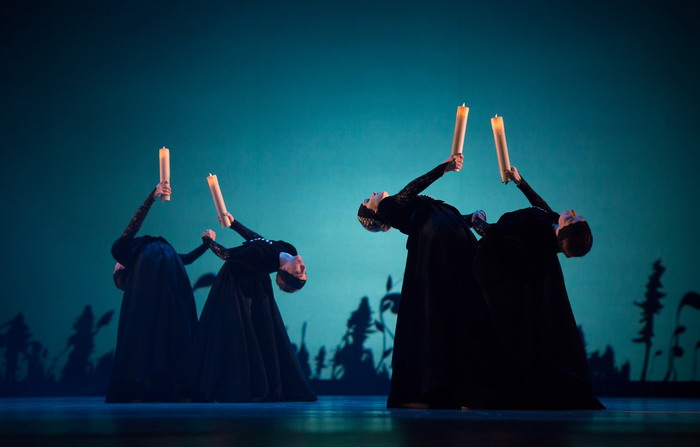 The National Theatre Ballet have performed for their audiences a brand new dance story, which brings on the stage a dark world of an ancient legend about the eternal struggle between good and evil. The Sorcerer's Apprentice is, according to the theatre source, aimed at a young audiences, but it seems that this age specification is more of a marketing gimmick or necessity of our time, the imperative of which is a dual requirement: to pigeonhole and aim. In the case of a production, the components of which are combined in a functional piece that spins like a well-adjusted mill wheel on the mysterious clearing where the story takes place, a move like this is quite superfluous. The Sorcerer's Apprentice is a ballet production for children and adults alike. It is obvious that the team which created this piece worked with a cohesive vision: libretto was edited in cooperation between choreographer Jan Kodet and a team of directors Martin Kukučka - Lukáš Trpišovský, known as a duo SKUTR. The story is based on a Sorbian legend of a black magic apprentice Krabat that survives mainly in a literary form as a fairy tale for elder children in the well-known adaptation by Otfried Preussler. The German-language author, who was born in Liberec, died shortly before the premiere. His literary adaptation is the main source for the ballet, some motifs were inspired by an animated film, made by Karel Zeman in 1977.
The National Theatre Ballet have performed for their audiences a brand new dance story, which brings on the stage a dark world of an ancient legend about the eternal struggle between good and evil. The Sorcerer's Apprentice is, according to the theatre source, aimed at a young audiences, but it seems that this age specification is more of a marketing gimmick or necessity of our time, the imperative of which is a dual requirement: to pigeonhole and aim. In the case of a production, the components of which are combined in a functional piece that spins like a well-adjusted mill wheel on the mysterious clearing where the story takes place, a move like this is quite superfluous. The Sorcerer's Apprentice is a ballet production for children and adults alike. It is obvious that the team which created this piece worked with a cohesive vision: libretto was edited in cooperation between choreographer Jan Kodet and a team of directors Martin Kukučka - Lukáš Trpišovský, known as a duo SKUTR. The story is based on a Sorbian legend of a black magic apprentice Krabat that survives mainly in a literary form as a fairy tale for elder children in the well-known adaptation by Otfried Preussler. The German-language author, who was born in Liberec, died shortly before the premiere. His literary adaptation is the main source for the ballet, some motifs were inspired by an animated film, made by Karel Zeman in 1977.The original story takes place over the period of three years, in the settings of the Thirty Years War and its horrors. Tales of schools of black magic are one of its manifestations in the realm of folklore. The fascination of contemporary society with magic and the supernatural, which seems to deny the whole Age of Enlightenment and positivism in both social and natural sciences, is a breeding ground for yet another adaptation of the tale. He who has read the book would find out that the original story was not only shortened, but more emphasis was put on the love theme too: apart from the character of the Master, who commands the mill at the Black water and is subordinate to a mysterious unnamed commander of his order, who is called "the Godfather", and the twelve apprentices, of whom we know Krabat, Toník, Liško and Jura by their
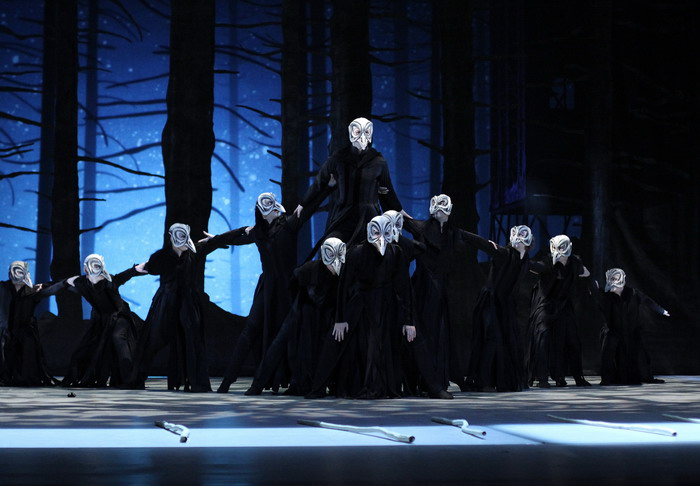 names, girls are more involved in the story too. In the legend Toník’s love affair is a mere memory, while in the production we go through it with him to the tragic end: his beloved got a more contemporary name Dorotka, Krabat’s girl is Kristýnka (her real name is not mentioned in the legend, she is known only by her nickname Kantorka that Krabat gave her for her beautiful singing on Easter Sunday, when she sang to the procession). In the ballet there is no trace of humour or relief, which is not missing in some other episodes of this gloomy story (anyway, Zeman in his film avoided any deviation from the dark atmosphere too, trying to force any change in mood might turn out to be a dramaturgical mistake).
names, girls are more involved in the story too. In the legend Toník’s love affair is a mere memory, while in the production we go through it with him to the tragic end: his beloved got a more contemporary name Dorotka, Krabat’s girl is Kristýnka (her real name is not mentioned in the legend, she is known only by her nickname Kantorka that Krabat gave her for her beautiful singing on Easter Sunday, when she sang to the procession). In the ballet there is no trace of humour or relief, which is not missing in some other episodes of this gloomy story (anyway, Zeman in his film avoided any deviation from the dark atmosphere too, trying to force any change in mood might turn out to be a dramaturgical mistake).The ballet is worth going through from the beginning to the end. The first scene brings us to a country ravaged by war – snow is falling on dead bodies scattered over the battlefield and gloomy presence of death, represented by the Godfather, lingers over the landscape. A beggar boy Krabat passes by and is called by a mysterious voice to the black mill. The Master welcomes him and with their handshake Krabat becomes his disciple and forfeits his life to him. And because there are twelve disciples (a magic number that pervades cultural patterns across all civilizations) at the black mill once again, the mill wheel starts moving as well. So far we only see them as a shadow image, but a very impressive one. After all, the stage design by Jakub Kopecký is austere and functional, it is not abstract, but highly stylized, it is not realistic, yet intensely captivating in its simplicity. Construction of the mill is frightening, the stage remains for most of the time dark, the light emphasizes the spatial dimension and becomes a stage-defining element (lighting design is by Daniel Tesař).
Krabat gets acquainted with the journeymen and the probationary period is full of hard work – in the scene where Krabat sweeps flour in a closed mill room and a compassionate journeyman Toník finishes the work by a magic formula female corps de ballet appear on the stage (the only question is if an audience unfamiliar with the literary source would get that the girls with pointe shoes, dressed in white costumes with fringes symbolize the flour dust). Krabat and Toník become friends and keep each other company on the Easter night. Journeymen are divided into pairs and told to stay awake all night at a secluded place, where some person has lost his or her life by mischance. Master made a magic sign on their foreheads that they must not wash off. Krabat and Toník sit down at a cross on the edge of a forest, watching a procession of girls from a village announcing the resurrection of Christ. They watch the girls during their ritual: first comes a procession of twelve girls with candles, dressed in black with green lining, which is a colour that can be seen either as a symbol of spring, or as a liturgical colour related to the Sunday Liturgy of the Word (although the Easter Mass is celebrated in white) that refers to the contrast between the pure Christian faith and the black magic. After taking off the outer garments that lie stretched beneath the girls like a lawn they dance in white chemises. When they eventually see the boys, all flee but two of them who lag behind and a mutual affection is born. Dorotka is the more daring of the two and dances a love duet with Toník (the swiftness of their affection is somewhat surprising, given that she saw him for the first time in her life). After coming back to the mill, all journeymen gather to study magic from the book of hell Koraktor, only the Master may read in. They participate in the teaching transformed into ravens – on the stage, this is always symbolized by masks with bird beaks and vests with feathers, supplemented with long coats. (Costume designer is Alexandra Grusková).
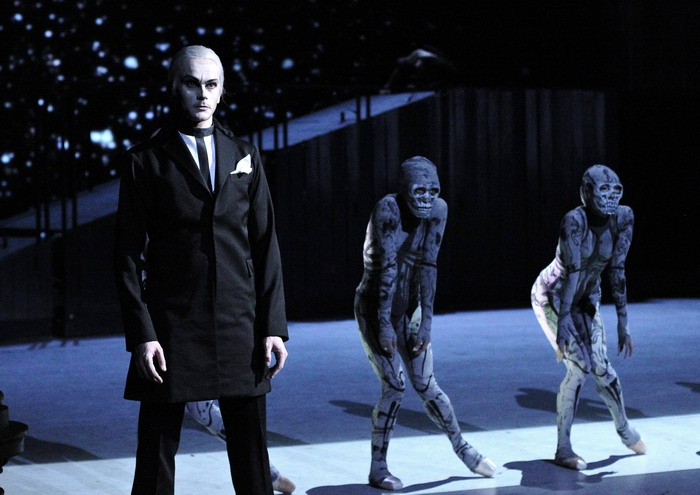 Godfather appears on the stage: he does not dance, he just acts by his mere presence. However, this role is challenging because its success or failure depends on handling of the stage machinery, in the course of the performance Godfather drops on the stage from ropes and flies in several times. Typical of his character is a gray wig and deathly-pale make-up. Journeymen handle a bizarre shipment – skeletons. These are portrayed by female dancers dressed in gray, full-body leotards with drawings of skeletons on them, ghastly masks and pointe shoes. The skeletons beckon to make a somewhat more imaginative danse macabre with them, unfortunately, in this case they are more like objects that are fetched and pushed to the mill and grinded. Krabat is frightened by this horrifying scene and tries to flee, but realizes that his effort is futile.
Godfather appears on the stage: he does not dance, he just acts by his mere presence. However, this role is challenging because its success or failure depends on handling of the stage machinery, in the course of the performance Godfather drops on the stage from ropes and flies in several times. Typical of his character is a gray wig and deathly-pale make-up. Journeymen handle a bizarre shipment – skeletons. These are portrayed by female dancers dressed in gray, full-body leotards with drawings of skeletons on them, ghastly masks and pointe shoes. The skeletons beckon to make a somewhat more imaginative danse macabre with them, unfortunately, in this case they are more like objects that are fetched and pushed to the mill and grinded. Krabat is frightened by this horrifying scene and tries to flee, but realizes that his effort is futile.Toník and Dorotka have a date in the woods, playing the blind man's buff like little kids. Master, who is watching them immobilizes Toník with a spell and lures Dorotka into a pond where the girl drowns. The effect of water surface that reflects the branches of trees is projected on the horizon (animations were created by Jan Zajíček, who was inspired by Zeman also in using grass silhouettes to evoke the atmosphere of a night meadow). However, when the drowned Dorotka floats on the horizon, the scene looks way too naturalistic.
Furious Toník challenges the Master to a duel and dies, both lovers are then buried in one grave. Meanwhile Jura enters the stage. This character is portrayed in the book as a simpleton, who turns out to be an intelligent young man pretending dumbness, however, there is no way to show such nuances in the production, we see only that he wants to help Krabat. Krabat has strange dreams about Kristýnka, the boys and other girls, but also about Toník and Dorotka, who live out their love. In his dream the Master tries to kill Kristýnka the same way he did with Dorotka. Nevertheless, the dream sequence is somewhat complicated.
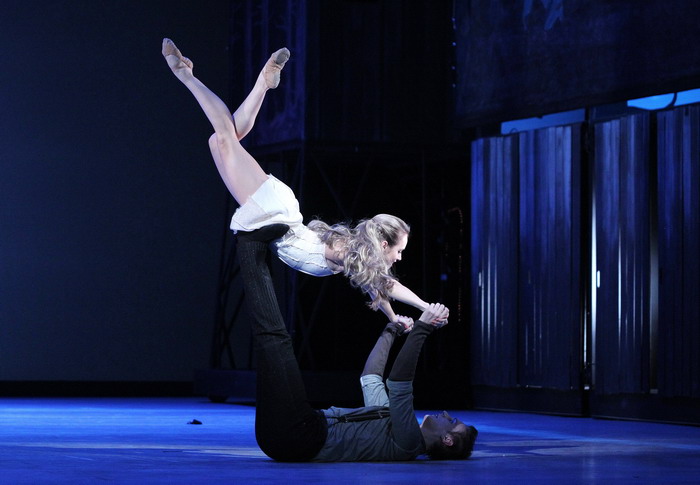 Meanwhile Jura reads in Koraktor. The following scene could be also interpreted as a vision of how Jura learns from the book that the Master's power can be broken by a loving girl who would claim her beloved and recognize him in a test. The Master’s defeat is shown in the back part of the stage, once again, the lighting is clearly demarcated here. However, we can also read the scene in a realistic way, as the makers intended – Jura has witnessed the Godfather’s visit and his warning to the Master that love can thwart both his power and life.
Meanwhile Jura reads in Koraktor. The following scene could be also interpreted as a vision of how Jura learns from the book that the Master's power can be broken by a loving girl who would claim her beloved and recognize him in a test. The Master’s defeat is shown in the back part of the stage, once again, the lighting is clearly demarcated here. However, we can also read the scene in a realistic way, as the makers intended – Jura has witnessed the Godfather’s visit and his warning to the Master that love can thwart both his power and life.Easter Night comes once again, the girls stay for a while at the grave Toník and Dorotka are buried in, Kristýnka stays a bit longer and meets Krabat. They dance together until he is recalled back to the mill. There is a new apprentice and work is back on track. The Master, however, realizes that there is something wrong with Krabat and shadows him to find out who his belowed is. Krabat, having a date with Kristýnka uses different magic disguises to get out of Master's sight – he turns both of them into a pair of wild geese, fish and flowers (the transformations are depicted by a fitting animation, clearly inspired by the film). The Master challenges Krabat to a duel, Jura rushes in to help the latter, but the Master turns him into a beast. In this form Jura seeks Kristýnka to ask her to rescue Krabat. She indeed comes and claims her beloved. She must recognize him among others, all turned into ravens. First it seems that the task is hopeless, but she recognizes her lover by his beating heart. The Master is defeated and Godfather comes (or, actually, flies in) to seize him. Unlike the traditional end with burning down the mill, which ought to purge the place of evil, a scene of boys and girls joyfully dancing together follows.
Jan Kodet’s choreography is well within the realm of traditional modern dance. The female dancers dance in pointe shoes only in two scenes, which, however, are not related to their womanhood. In the corps de ballet scenes he works with different variable forms accentuated by lighting design, but we can say that the movement itself is the least symbolic aspect of the production, symbolism is based more on the visual aspect, on the costumes and props. The movement works wholly for the storyline and psychological characterization of individual parts. Integrity, balance and stylistic purity are hardly of any surprise to us with such an experienced author. Choreography does not incline towards pantomime, but employs walk and gestures in an appropriate manner, there are several beautiful love duets and dynamic solos too. The dance/movement depictions of the duels between the Master and Toník (and Krabat) are filled with energy, they show a rather non-contact and magic way of combat with dancers reacting to some unseen force.
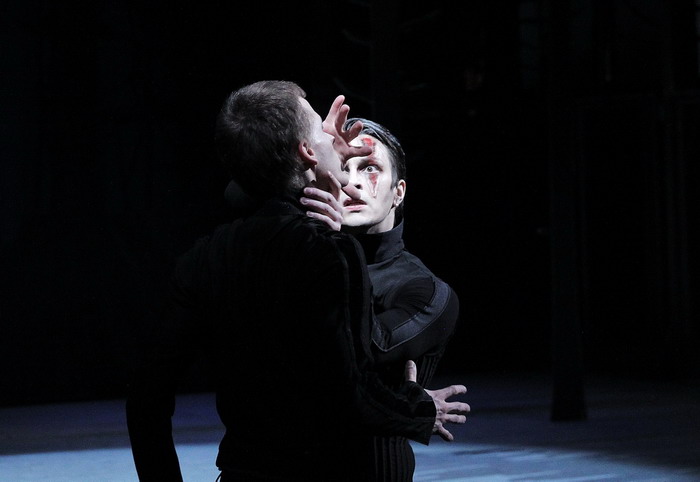 As for artistic expression, the most demanding parts in the production are those of the Master and Krabat, both of whom experience most mental stress throughout the story. The part of the Master is choreographed in such a way that allows both casts to use their peculiar physical abilities. Each of them has his own well-established style of interpretation, the part of the Master, however, is not based on an outward virtuosity, but on the ability to impress with his inner moods. Both casts, Alexandre Katsapov and Petr Zuska, have a rich stage experience with evil characters, so they can create their own interpretation: Katsapov is cunning, malicious and the more expressive of the two, anyway, this is also partly due to his talent as a dancer; Zuska is the more dignified and in critical situations the fiercer of them. However, it may be that such an impression is given by differences in physiognomy, naturally, it is not feasible to determine the inner emotions of an artist. More importantly, both protagonists identify with their roles on the stage and pass their emotions on to the audience.
Krabat (Viktor Konvalinka or Ondřej Vinklát) is the most demanding role in the production as for dancing. Viktor looks more boyish, while Ondřej more mature of the two, anyway, they both are well in tune with the dance morphology of the production. In a similar way, both casts of Toník (Marek Svobodník and Adam Zvonař) are quite equal in the role. Marek Svobodník makes the best of his height and long elegant arms, Adam Zvonař looks more childlike. Jonáš Dolník and Veaceslav Burlac as Jura are quite different as dancers, the first of them due to his light build gives an impression of an oppressed fellow, who surprises with his activity, the latter is lively from the beginning. Zuzana Susová and Kristýna Němečková are cast as Dorotka; Zuzana Susová in this minor role draws on her experience and we can easily believe she is a young girl, her feelings are genuine and movements distinguished by finesse. Zuzana Šimáková and Morgane Lanoue are equal in their performances.
As for artistic expression, the most demanding parts in the production are those of the Master and Krabat, both of whom experience most mental stress throughout the story. The part of the Master is choreographed in such a way that allows both casts to use their peculiar physical abilities. Each of them has his own well-established style of interpretation, the part of the Master, however, is not based on an outward virtuosity, but on the ability to impress with his inner moods. Both casts, Alexandre Katsapov and Petr Zuska, have a rich stage experience with evil characters, so they can create their own interpretation: Katsapov is cunning, malicious and the more expressive of the two, anyway, this is also partly due to his talent as a dancer; Zuska is the more dignified and in critical situations the fiercer of them. However, it may be that such an impression is given by differences in physiognomy, naturally, it is not feasible to determine the inner emotions of an artist. More importantly, both protagonists identify with their roles on the stage and pass their emotions on to the audience.
Krabat (Viktor Konvalinka or Ondřej Vinklát) is the most demanding role in the production as for dancing. Viktor looks more boyish, while Ondřej more mature of the two, anyway, they both are well in tune with the dance morphology of the production. In a similar way, both casts of Toník (Marek Svobodník and Adam Zvonař) are quite equal in the role. Marek Svobodník makes the best of his height and long elegant arms, Adam Zvonař looks more childlike. Jonáš Dolník and Veaceslav Burlac as Jura are quite different as dancers, the first of them due to his light build gives an impression of an oppressed fellow, who surprises with his activity, the latter is lively from the beginning. Zuzana Susová and Kristýna Němečková are cast as Dorotka; Zuzana Susová in this minor role draws on her experience and we can easily believe she is a young girl, her feelings are genuine and movements distinguished by finesse. Zuzana Šimáková and Morgane Lanoue are equal in their performances.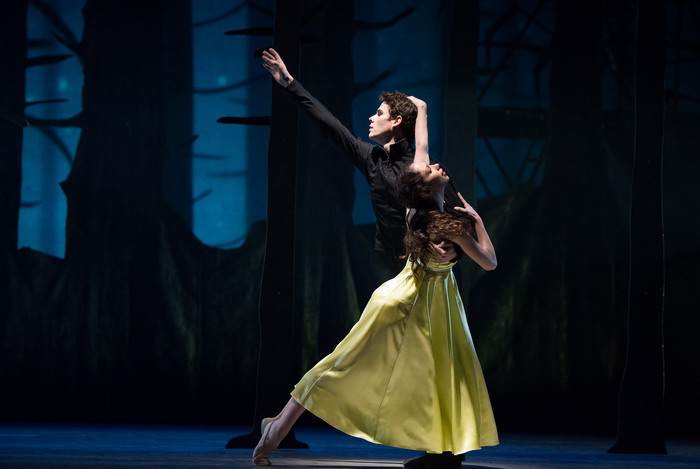 Music, composed by Zbyněk Matějů substantially contributes to the outcome of the production. It is multifaceted in terms of compositional techniques and the use of the orchestra. It works with three different components, due to which there is a touch of interactivity to it: a small orchestra is supplemented by orchestral recording, played from tape (often in the same setup, but the sound effect is enhanced by multiplication) and a specific music, all of which creates a sound landscape of the production. Zbyněk Matějů combines several techniques of contemporary music, he forsakes motivic work with the melody and focuses on assonance instead. We can recognize some techniques of minimalism, timbre music, cluster chords, some rapid changes of metrorhythmical link, referring as much back as Stravinsky. It is difficult to find a somewhat more elaborate musical theme here (except for the waltz in Krabat’s dream, which is partially melodic), everything conforms to the mood and colour. The music sounds impressive and due to the complex rendition combined with specific sounds it captivates the audience.
Music, composed by Zbyněk Matějů substantially contributes to the outcome of the production. It is multifaceted in terms of compositional techniques and the use of the orchestra. It works with three different components, due to which there is a touch of interactivity to it: a small orchestra is supplemented by orchestral recording, played from tape (often in the same setup, but the sound effect is enhanced by multiplication) and a specific music, all of which creates a sound landscape of the production. Zbyněk Matějů combines several techniques of contemporary music, he forsakes motivic work with the melody and focuses on assonance instead. We can recognize some techniques of minimalism, timbre music, cluster chords, some rapid changes of metrorhythmical link, referring as much back as Stravinsky. It is difficult to find a somewhat more elaborate musical theme here (except for the waltz in Krabat’s dream, which is partially melodic), everything conforms to the mood and colour. The music sounds impressive and due to the complex rendition combined with specific sounds it captivates the audience.The stage design and costumes have been already mentioned, these components are as well-balanced as the rest of the production. What may be the most problematic aspect of the production is the use of stage technology, which is spectacular, but reduces the character of the Godfather (Jiří Kodym) to a strictly symbolic role, devoid of any dancing. In the final scene the audiences rather worry about the correct timing of the "deportation" of the Master than enjoy the experience of catharsis. Another ambiguous thing is the staffs with lit upper ends that the dancers use as props. Or rather, they are not that ambiguous if we take them as a reference to a modern visual concept of a wizard as recently established by film industry, but in the context of otherwise pure and historically grounded stage image they seem to be an unnecessary sop. Nevertheless, apart from these details and some above-mentioned discrepancies the production undoubtedly works as a whole. Still, the question is whether the gloomy mood of the piece would harm its future or not.
The Sorcerer's Apprentice
Libretto: Jan Kodet, Martin Kukučka, Lukáš Trpišovský
Music: Zbyněk Matějů
Choreography: Jan Kodet
Directed by: SKUTR (M. Kukučka, L. Trpišovský)
Stage design: Jakub Kopecký
Costumes: Alexandra Grusková
Lighting Design: Daniel Tesař
Animation: Jan Zajíček
Assistant choreographers: Michaela Černá, Zuzana Susová, Radek Vrátil
World Premiere: February 28th and March 1st, 2013

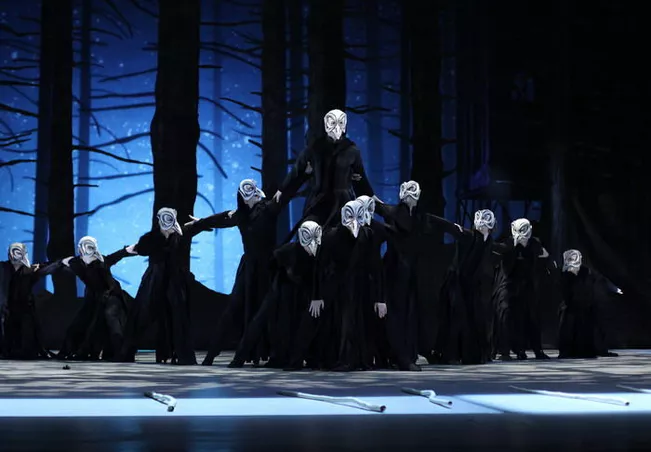



Josef Bartos
Thank you for your thoughts. One got stuck in my mind – that passion makes us different from AI. Just yesterday I read…I am a dance critic. I am a member of an endangered species